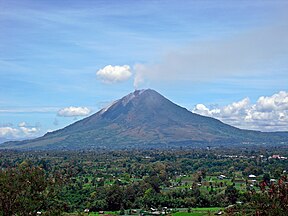| Mount Sinabung | |
|---|---|
| Gunung Sinabung (Indonesian) Deleng Sinabung (Karo) | |
 Sinabung in 2010 | |
| Highest point | |
| Elevation | 2,460 m (8,070 ft)[1] |
| Listing | Ribu |
| Coordinates | 3°10′12″N 98°23′31″E / 3.17°N 98.392°E |
| Geography | |
| Geology | |
| Rock age | Pleistocene |
| Mountain type | Stratovolcano |
| Volcanic arc | Sunda Arc |
| Last eruption | 2021[1] |
Mount Sinabung (Indonesian: Gunung Sinabung,[2] Karo: Deleng Sinabung[3]) is a Pleistocene-to-Holocene stratovolcano of andesite and dacite in the Karo plateau of Karo Regency, North Sumatra, Indonesia, 40 kilometres (25 mi) from the Lake Toba supervolcano. Many old lava flows are on its flanks and the last known eruption, before recent times, occurred 1200 years before present, between 740 - 880 CE.[4] Solfataric activities (cracks where steam, gas, and lava are emitted) were last observed at the summit in 1912; recent documented events include an eruption in the early hours of 29 August 2010 and eruptions in September and November 2013, January, February and October 2014.[1][5] The volcano has recently claimed the life of at least 23 people in a number of events since 2014.[6] [7] Between 2013 and 2014, the alert for a major event was increased with no significant activity. On 2 June 2015, the alert was again increased, and on 26 June 2015, at least 10,000 people were evacuated,[8] fearing a major eruption.[8] The long eruption of Mount Sinabung is similar to that of Mount Unzen in Japan, which erupted for five years after lying dormant for 400 years.[9] A major eruption began on 10 August 2020.[10]
- ^ a b c "Sinabung". Global Volcanism Program. Smithsonian Institution. Retrieved 2006-12-18.
- ^ "Gunung Sinabung: Indonesia". Geographical Names. Retrieved 2013-02-03.
- ^ "Deleng Sinabun: Indonesia". Geographical Names. Retrieved 2013-02-03.
- ^ "Bulletin of the Global Volcanism Network". Global Volcanism Program. Smithsonian Institution. April 2018. Retrieved 2019-08-25.
- ^ "Mount Sinabung in Sumatra erupts". The Jakarta Post. Archived from the original on 2010-08-31. Retrieved 2010-08-29.
- ^ Cite error: The named reference
:1was invoked but never defined (see the help page). - ^ "Search for survivors after deadly Mount Sinabung volcanic eruption". ABC News. 2016-05-23. Retrieved 2016-05-25.
- ^ a b "Indonesia volcano erupts three times in hours".
- ^ Ida Ayu Made Sadnyari (June 3, 2015). "Awas, Volume Kubah Lava Gunung Sinabung Meningkat".
- ^ Domonoske, Camila (10 August 2020). "PHOTOS: Indonesia's Volcano Mount Sinabung Erupts, Spewing Ash Miles High". NPR.
